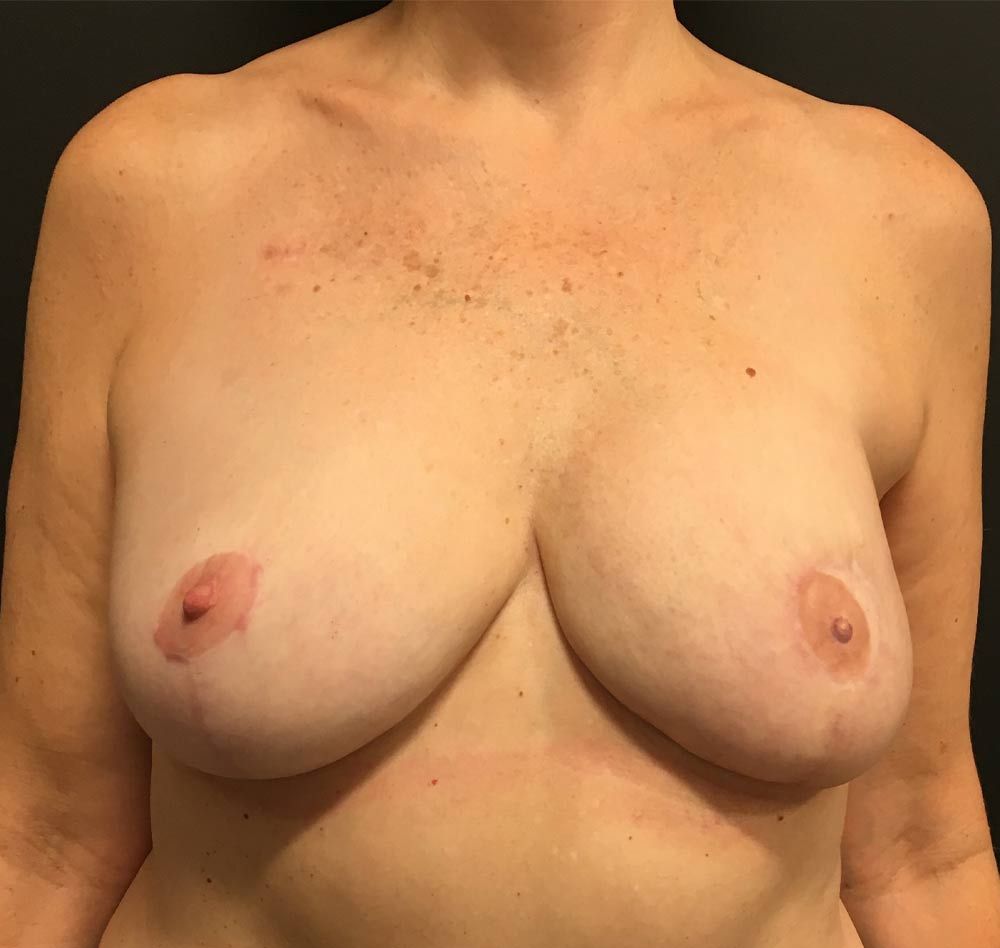Breast cancer is a complex disease that affects millions of women worldwide. In many cases, breast cancer treatment involves the surgical removal of one or both breasts (mastectomy), followed by potential chemotherapy and radiation therapy. This can leave many women feeling self-conscious and unhappy with their final breast appearance. Radiation can cause significant complications when tissue expanders or breast implants are present. One option that has the best outcomes is autologous breast reconstruction after breast radiation.
What Complications Occur with Radiation to the Breast?
Capsular Contracture with Radiation Therapy – Hard Implant after Radiation
Capsular contracture is a condition where thickened scar tissue forms around the breast implant, causing it to harden, become misshapen, rise upwards, and become painful. Radiation therapy always increases the risk of capsular contracture – it’s just a matter of what degree. When this occurs, it can be obvious when wearing clothes and can also become painful. Usually the only way to correct this is to remove the implant entirely and replace it with a flap of a patient’s own tissues (usually a DIEP flap). Many patients ask whether the implant can just be replaced. However, it’s not the implant that is the problem – it’s all the radiated mastectomy skin around the implant. The radiated tissue around an implant will always react and contract, no matter whether the implant is replaced with a new one or a different kind/size.
Breast Implant Rupture or Leakage with Radiation Therapy
The capsular contracture that occurs with radiation therapy can squeeze and fold the silicone shell of the implant, eventually leading to early rupture or leakage. If this happens, the implant may need to be removed or replaced with a new implant. If the radiation damage is so severe that it is contracting the implant, it is safer and more comfortable to remove the implant and perform flap reconstruction with one’s own tissues. The most common flap reconstruction after radiation therapy to the breast is a DIEP flap.
Changes in Breast Shape and Size with Radiation Therapy
Radiation can cause the breast tissue to shrink or become firmer, which can lead to changes in the shape or size of the breast implant. This occurs because radiation melts some of the normal fat underneath the mastectomy skin. Radiation can also cause the breast to become fuller due to chronic edema (fluid in the skin/tissues).
Delayed Wound Healing with Radiation Therapy of Breast
Radiation can affect the skin’s ability to heal after surgery, which can lead to delayed wound healing and an increased risk of infection.
Increased risk of infection with Radiation Therapy of Breast
Radiation therapy can weaken the immune system, making it more difficult to fight off infections. Combined with poor healing, this can increase the risk of infection after breast implant surgery.
Treatment Options after Radiation Therapy to the Breast
The treatment of radiated breast implants depends on the severity of the radiation and the breast deformity. In addition, it depends on the availability of options, the best being a flap reconstruction using a patient’s own tissue. Finally, it depends on the overall health and age of the patient to determine whether they are a candidate for a longer flap reconstruction surgery.
Timing of Breast Reconstruction with Radiation Therapy
There are two scenarios when radiation therapy can affect implant breast reconstruction:
- Radiation Therapy Before Mastectomy. This occurs when a patient had previous breast cancer and chose to undergo breast conservation therapy which includes a lumpectomy (also known as a partial mastectomy) and radiation therapy. If these patients develop a recurrence or a new cancer and a mastectomy needs to be performed on the radiated breast, it is much higher risk since it has already undergone the permanent damage from radiation. In this scenario, tissue expanders or implants are not recommended due to their high complication and failure rate. For these patients, it is best to perform flap reconstruction using a patient’s own tissue at the time of the mastectomy. The most commonly performed flap after breast radiation is a DIEP flap.
- Radiation Therapy After Mastectomy. This occurs when patients are diagnosed with breast cancer and any of the following criteria are met*:
- The cancer on final pathology is larger than 5 cm (about 2 inches)
- The cancer has spread to more than one lymph node (called a positive or involved nodes)
- The cancer has positive margins, meaning it was at the edge of the mastectomy tissue that was removed – either facing the chest wall/muscle or the skin.
*There are many nuances to these criteria for radiation therapy depending on a patient’s age, the cancer characteristics, and a patient’s response to chemotherapy. These are discussed with a patient’s oncologist and radiation oncologist.
For patients that may need radiation therapy after mastectomy, reconstruction is best performed in a staged fashion. At the time of the mastectomy, tissue expanders are placed as a space holder for a future flap reconstruction. The reason a flap is best not performed at the same time as the mastectomy is to avoid radiation to the flap since it will shrink and contract the flap. After radiation is complete, and usually after waiting 6 months for the skin to recover from radiation, the tissue expander can be removed and flap reconstruction can be performed.
For example, if a DIEP flap is performed at the same surgery as the mastectomy, and then the patient is found to need radiation therapy (based on the final pathology and status of the lymph nodes), then the radiation will shrink the DIEP flap and make it fibrotic and potentially distorted. There is only one chance to use the lower abdominal tissue for a DIEP flap and it can’t be redone. Therefore, a tissue expander is used as a space holder and the DIEP flap would be performed after radiation therapy.
It’s important to discuss the risks and benefits of undergoing tissue expander or implant reconstruction if you have had previous radiation surgery or may need radiation therapy. Regular follow-up appointments with your plastic surgeon are crucial to ensure the ongoing health and safety of your breast reconstruction.
Best Breast Reconstruction after Radiation Therapy
The best breast reconstruction after radiation therapy is autologous reconstruction, which means using a patient’s own tissue. When tissue is completely detached from one location and moved/transplanted to another location on a patient’s body, this is called a “flap”. This involves microsurgery to reattach the blood vessels and is performed by specially trained microsurgeons.
The most common flap performed for breast reconstruction, especially in the treatment of radiated breasts, is a DIEP flap. This surgery uses the lower abdominal skin and fat, very similar to what is removed and discarded in a tummy tuck, to reconstruct the breasts.
A small percentage of patients are not candidates for a DIEP flap due to a previous abdominoplasty or not having enough tissue on the lower abdomen. Although this is rare, the second most common site is using tissue from the upper thigh area, either a TUG flap or a PAP flap.
The process of transplanting healthy non-radiated tissue to the radiated breast area improves the reconstruction, avoids the use of hard contracted implants, and feels and looks much more natural. These procedures have a very high satisfaction with patients who have undergone mastectomies and radiation therapy.
How Jandali Plastic Surgery Can Help with Complications of Radiated Breast Implants
Jandali Plastic Surgery can provide comprehensive care and treatment for patients with radiated breast implants. We understand the unique challenges that patients face after undergoing mastectomy and radiation therapy.
The following are some of the ways in which we can help patients with radiated breast implants:
Breast Implant Removal and Replacement after Radiation
Dr. Jandali has extensive experience in performing implant removal and replacement on radiated breasts. He will review the risks and benefits of continued implant use and assess whether you are a candidate for a flap reconstruction.
Flap Reconstruction after Radiation
If the breast skin has been damaged due to radiation, our Connecticut plastic surgeon can perform flap reconstruction surgery to restore the appearance of the affected breast. This can be performed if the implant is still in place or if the implant has been removed due to previous complications. Dr. Jandali will review the flap options and determine which one is best for you. He will review before and after photos of similar patients to give a good idea of the expected outcome.


Frequently Asked Questions
Can breast implants be safely used after radiation therapy for breast cancer?
Breast implants can be used after radiation therapy for breast cancer, but there are some risks and potential complications that need to be considered. In multiple published studies, the overall risk of complication is around 30%. Patients should discuss the risks and benefits with their plastic surgeon and make an informed decision.
Will radiation therapy damage breast implants?
Radiation therapy can damage breast implants, particularly by causing the tissue and skin around the implants to harden. This can squeeze the implant, folding the edges, and causing early rupture.
How long after radiation therapy can breast implant surgery be performed?
The timing of breast implant surgery after radiation therapy can vary depending on the individual case. Generally, it is recommended to wait at least 6 months after radiation therapy before having breast implant surgery or switching a tissue expander to an implant.
How can complications with radiated breast implants be treated?
Complications with radiated breast implants need to be treated with surgery. This can include implant removal, implant replacement, or flap reconstruction.
What is autologous breast reconstruction?
Autologous breast reconstruction is a type of breast reconstruction surgery that uses tissue from the patient’s own body to rebuild the breast. This tissue can be taken from the abdomen, thighs, or buttocks and used to create a new breast mound. The advantage of this approach is that the patient’s own tissue is used, resulting in a more natural look and feel.
How does radiation affect breast reconstruction?
Radiation therapy is often used after breast cancer surgery to destroy any remaining cancer cells. While radiation therapy is highly effective, it can also cause damage to the tissue surrounding the breast implant or reconstructed breast. This damage can lead to complications such as capsular contracture, implant infection, early implant rupture, delayed wound healing, and possible loss of an implant.
What is capsular contracture?
Capsular contracture is a condition in which the scar tissue that forms around the breast implant tightens and contracts, causing the breast to feel and look hard and potentially be painful. This always occurs with radiation therapy – it’s just a matter of to what degree.
Why choose flap breast reconstruction after breast radiation?
One of the main advantages of flap breast reconstruction after breast radiation is that it can help to mitigate the risks associated with radiation therapy. Because the patient’s own non-radiated tissue is used, there is a much lower risk of complications compared to implant. Additionally, autologous breast reconstruction can help to restore the natural shape and feel of the breast, which can be lost after radiation therapy.
Can breast implant radiation be reversed?
Unfortunately, the negative changes that occur with breast implant radiation cannot be reversed. They are worst in the first 6 months after surgery, which is why any revision or flap reconstruction is delayed for 6 months after radiation therapy. However, the changes to the breast skin and the additional risks associated with radiation last forever.
Contact Us
If you or a loved one has needed to undergo mastectomy and radiation therapy, and would like to discuss options for reconstruction, schedule an appointment with Board Certified Plastic Surgeon Dr. Shareef Jandali.

